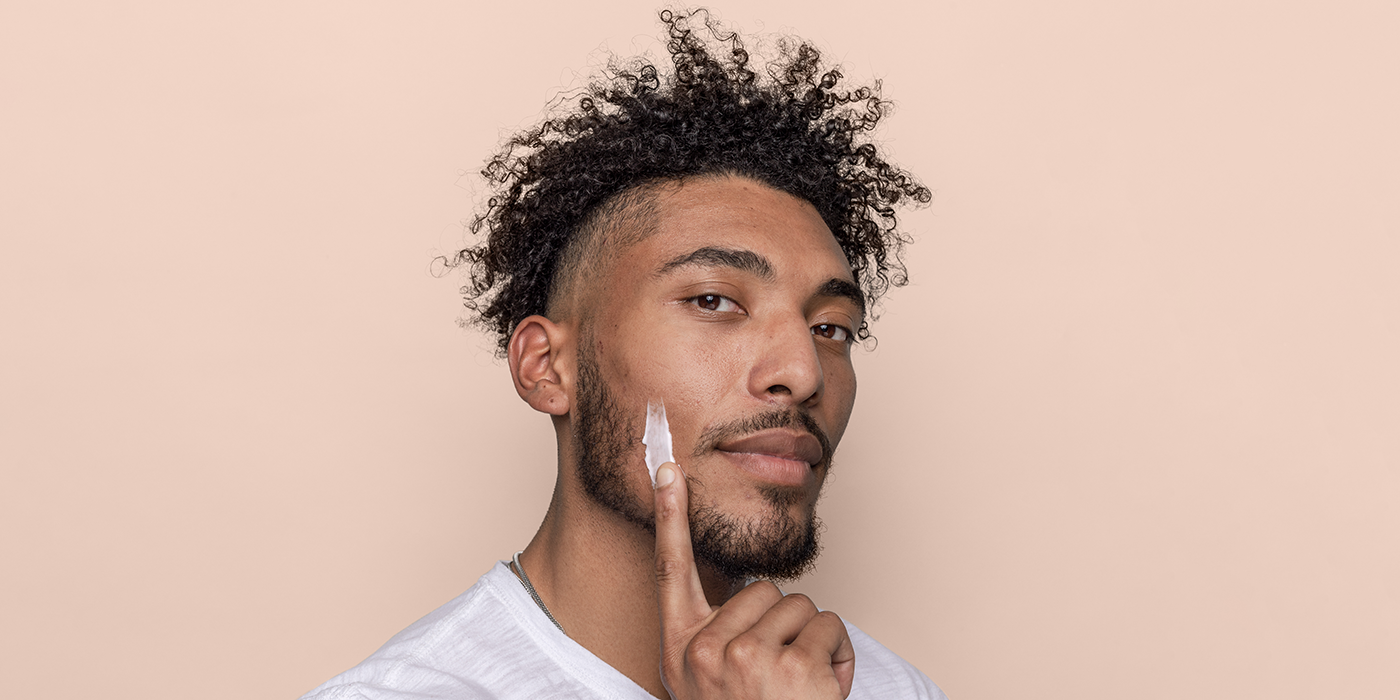How it works:
Share your skin goals and snap selfies
Your dermatology provider prescribes your formula
Apply nightly for happy, healthy skin
How it works:
How it works:
Share your skin goals and snap selfies
Your dermatology provider prescribes your formula
Apply nightly for happy, healthy skin
How it works:
Men's skincare: Expert-approved shaving and beard care tips
Maintain your facial hair the right way, and your skin will thank you!



If you’re suffering from dry skin, ingrown hairs, or acne after you shave, your beard care products might be to blame. Irritating and pore-clogging ingredients are very common in shaving cream and aftershave lotions, which can upset the skin beneath.
Skincare doesn’t stop just above your facial hair! The right beard care tips will help you avoid beard rash and razor burn. Plus, our licensed dermatology providers will give you the details on a top skincare ingredient—shea butter—and explain how you can incorporate it into your beard care routine.
Beard care routine: The basics
For best results, shave after showering, if possible, when your facial hair is the softest.¹ To begin, soak your fuzzy face and neck with shaving cream for several minutes before starting your shave. Then, apply a moisturizing aftershave balm when you’re finished.
If you’re prone to ingrown beard hairs, you might be shaving a little too frequently—letting your beard grow out a bit has the benefit of potentially preventing razor bumps. And for many, using an electric razor is the best bet.
If you choose to use a blade razor, here are some tips for the best shave:²
Swap your razor blade for a fresh one every 5 to 7 shaves.
Shaving against the grain can encourage ingrown hairs, so it’s best to shave in the direction your hair grows.
Rinse your razor off with water after each pass across your skin.
Wash your razor after each use and store it in a dry area to prevent bacteria from building up.
Whether you use a face foamer, beard oil, or any other product, make sure they don’t contain ingredients that can irritate your skin or clog pores. And after shaving, you should cleanse your face to remove any lingering product residue.
Ingredients to avoid in men’s shaving
If you want to decipher the ingredients of your skin and beard care products, you can use our helpful guide to analyze whether or not they’re potentially pore-clogging. Unfortunately, men’s skincare is positively overrun with ingredients commonly known to be potentially pore-clogging and irritating. Here are the most common ones we’ve come across:
Glyceryl-3-diisostearate
Myristyl myristate
Sodium lauryl sulfate
Laureth-4
Isopropyl Palmitate
Isopropyl Myristate
Coconut oil
Denatured Alcohol
Fragrance
Some ingredients—like alcohol and fragrance��—may be difficult to avoid completely, so keep in mind that the higher up an ingredient is on a list, the more of it is contained within the product. And if a product has several ingredients on its list known for causing acne and irritation, you may want to skip it.
Skin-friendly labels to look for in men’s shaving
So what ingredients or labels should you be looking for? Here’s a quick cheat sheet.
For men with oily skin, products containing salicylic acid or glycolic acid can be beneficial as they help control excess oil and gently exfoliate the skin. A good starting place is to look for the term “non-comedogenic” on the label, which means the product is less likely to clog your pores, reducing the risk of breakouts.³
If you have a normal skin type, maintaining balanced hydration without clogging pores is essential. Stick to products that also have the “non-comedogenic” label.⁴
Those with dry skin should opt for hydrating products to replenish skin moisture. Make sure to choose those labeled “fragrance-free” to avoid potential irritants that may irritate the skin.⁵
If you have sensitive skin, look for the words “soap-free” and “fragrance-free.” These help ensure that the product is free from harsh detergents and fragrances, both of which can irritate sensitive skin.⁶
Remember, everyone's skin is unique. So finding what works best for you may take some trial and error. It's always a good idea to consult a licensed dermatology provider with questions or concerns.
Can you use shea butter for beards?
Absolutely! Shea butter is an excellent ingredient to incorporate into your beard care routine. Derived from the mature fruit of the Vitellaria paradoxa tree, also known as Butyrospermum parkii, shea butter is a solid fat known for its remarkable skin benefits.⁷
A common ingredient in skin care, shea butter is prized for its moisturizing capabilities.⁸ These properties can be particularly beneficial for beards. They can help combat dryness and ensure the hair remains soft and manageable. Regular use of shea butter can help keep beard hairs well-hydrated, contributing to a fuller and more lustrous appearance.
Additionally, shea butter's natural ability to stimulate collagen production can be a boon for the skin underlying your beard.⁹ Collagen is a protein that contributes to skin elasticity and strength, which in turn can provide a healthier foundation for beard growth.
Research has highlighted shea butter's UV-B absorbing characteristics, suggesting its potential to act as a protective shield against harmful ultraviolet rays.¹⁰ This can help prevent photo-aging (premature skin aging caused by repeated exposure to ultraviolet radiation).
On top of all these benefits, shea butter also brings its potent anti-inflammatory and antioxidant properties to the table.¹¹ These can help soothe irritated skin, reducing redness and inflammation often associated with beard growth. The antioxidant qualities, meanwhile, can help protect the skin and beard from environmental stressors such as pollution and free radicals.
How to use shea butter for beard care
Shea butter can offer numerous benefits for your face and beard, but you might want to pause a moment before slathering it on. While pure shea butter has moisturizing and protective properties, it can be too heavy for some skin types and may contribute to clogged pores—this can potentially lead to breakouts.
To help prevent clogged pores, shea butter is often incorporated into other products like beard butters, beard balms, beard oils, and shave butters. In these formulas, it can deliver its benefits with less of a risk of causing acne.
Shave butters are an excellent alternative to traditional shaving creams. Shea butter in these products helps soften facial hair, ensuring the razor glides easily, reducing the risk of nicks and cuts. Simply apply a small amount to your beard before shaving, then rinse well afterward.
For those with a longer beard, beard balm containing shea butter can be a great choice. It coats each hair strand, leaving them soft and smooth to the touch. Just take a small amount, warm it between your fingers, and work it through your beard, ensuring every strand is coated.
Shea butter also finds its way into beard butters, which are perfect for deep conditioning. Apply the beard butter at night, massaging it into your beard to encourage deep penetration. Rinse in the morning for a conditioned, healthy-looking beard.
Beard oils infused with shea butter help to hydrate and nourish not just the facial hair but also the skin underneath. A few drops of oil massaged into the beard daily can work wonders, leaving both the beard and the skin well-nourished.
A beard’s best friend
It may be tough to tell the difference between breakouts and razor bumps but the good news is: Anti-acne ingredients may help treat inflammation caused by ingrown hairs too! Curology offers personalized prescription-strength topical creams with bump-busting ingredients such as tretinoin, azelaic acid, and clindamycin that exfoliate, improve hyperpigmentation, and clear bacteria.
Get your personalized skincare routine with Curology
Get your personalized skincare routine with Curology


Get started with Curology by taking a quick skin quiz and snapping a few photos of your skin concerns. One of our licensed dermatology providers will review your info and prescribe your personalized formula if Curology is right for you. Start your 30-day trial* today!
FAQs
Shea butter can be an excellent addition to your beard care routine. Well-known for its impressive moisturizing properties, shea butter helps to hydrate both your beard and the underlying skin.¹² Regular use can leave your beard feeling soft and manageable while also preventing skin dryness beneath the beard.
However, be mindful of potential pore-clogging if you have acne-prone skin; in such cases, it's better to use shea butter in combination with other ingredients in beard care products.
Shea butter is particularly beneficial for Black men's beards which can naturally be coarser. Its high fatty acids deeply moisturize and soften the hair strands.¹³ This can lead to a healthier, more manageable beard. In addition, shea butter can soothe the skin underneath, helping to prevent dryness and irritation.
The choice between beard oil and beard butter largely depends on your specific needs. If you're looking to moisturize your beard and tame unruly flyaways, beard butter might be your go-to. It provides a bit of hold and is excellent for maintaining beard shape. On the other hand, beard oil is fantastic for softening the beard and keeping the skin underneath well-hydrated, helping to prevent dryness and itching.
However, there might be no need to choose between the two. Using both in tandem, beard oil for hydration and beard butter for styling, could offer you the best results in your beard care routine.
P.S. We did the homework so you don’t have to:
American Academy of Dermatology Association. A Dermatologist’s Top Tips for a Healthy Beard. (2021, December 14).
American Academy of Dermatology Association. A Dermatologist’s Top Tips for a Healthy Beard. Ibid.
American Academy of Dermatology Association. A Dermatologist’s Top Tips for a Healthy Beard. Ibid.
American Academy of Dermatology Association. A Dermatologist’s Top Tips for a Healthy Beard. Ibid.
American Academy of Dermatology Association. A Dermatologist’s Top Tips for a Healthy Beard. Ibid.
American Academy of Dermatology Association. A Dermatologist’s Top Tips for a Healthy Beard. Ibid.
Ferreira, M.S., et al. Trends in the Use of Botanicals in Anti-Aging Cosmetics. Molecules. (2021, June 11).
Ferreira, M.S., et al. Trends in the Use of Botanicals in Anti-Aging Cosmetics. Molecules. Ibid.
Ferreira, M.S., et al. Trends in the Use of Botanicals in Anti-Aging Cosmetics. Molecules. Ibid.
Ferreira, M.S., et al. Trends in the Use of Botanicals in Anti-Aging Cosmetics. Molecules. Ibid.
Lin, T-K., et al. Anti-Inflammatory and Skin Barrier Repair Effects of Topical Application of Some Plant Oils. Int J Mol Sci. (2017, December 27).
Ferreira, M.S., et al. Trends in the Use of Botanicals in Anti-Aging Cosmetics. Molecules. Ibid.
Ferreira, M.S., et al. Trends in the Use of Botanicals in Anti-Aging Cosmetics. Molecules. Ibid.
Laura Phelan is a board-certified Family Nurse Practitioner at Curology. She earned her Masters of Science in Nursing at Benedictine University and went on to get her post-master’s certificate as a Family Nurse Practitioner at the University of Cincinnati.
*Cancel anytime. Subject to consultation. Results may vary.

Curology Team

Laura Phelan, NP-C